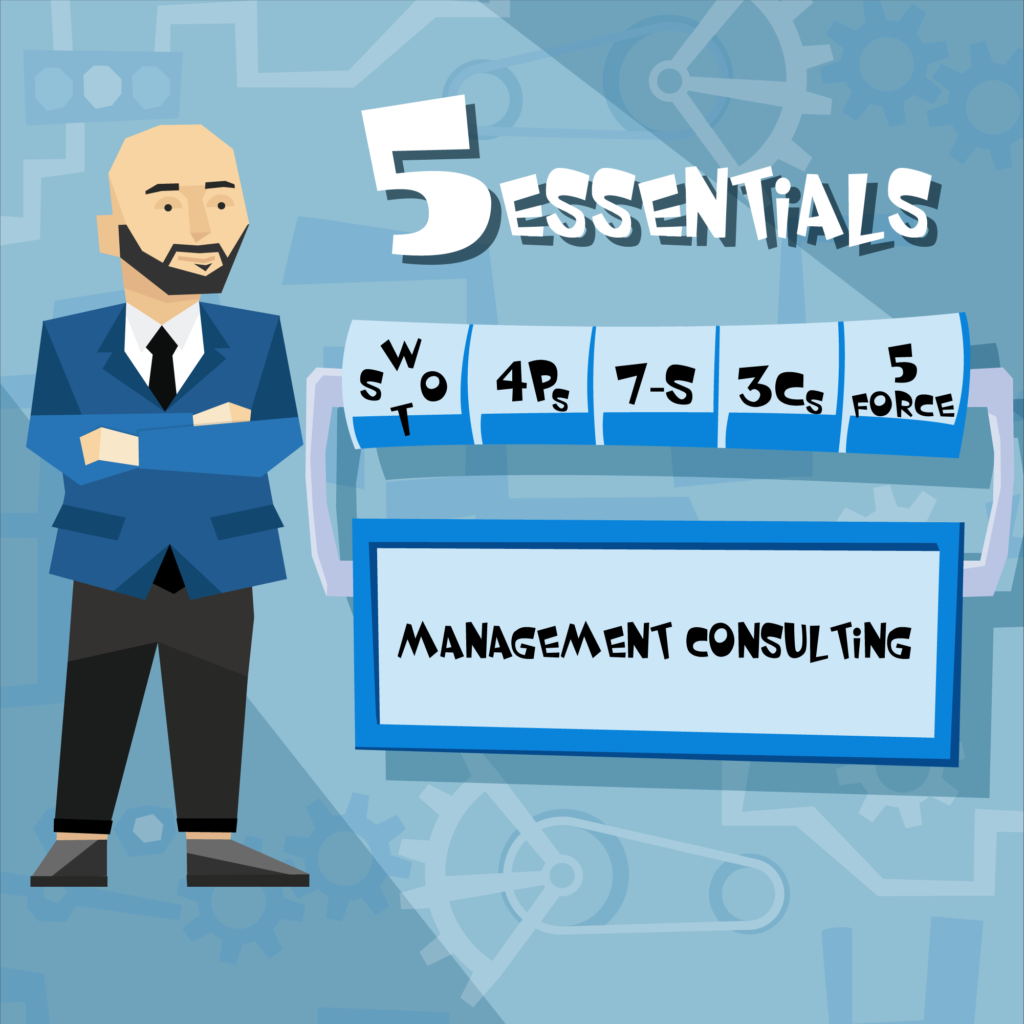5 Essential Management Consulting Frameworks

In an age of complex, advanced, IT and data-driven business strategic planning, there is still a critical role that business consultants play in ensuring that companies of all sizes can create the most efficient blueprint to meet their overarching business model and reach their end goals.
Business consultants have the key role of offering crucial advice and direction on a variety of business-related topics for all your various departments – from security, finance, and marketing, to R&D, IT, and customer service.
In order for businesses to monitor, analyze, structurally plan and communicate, each project that works towards the ultimate goal(s) that the business model entails, management consulting frameworks are often utilized as a set of enterprise-level tools or principles that can help business consultants, managers, executives, and data analysts gain a better grasp of how to move the company in the right direction.
As a set of tools – that is, a framework – such management systems do not replace standard IT systems, business sense, or executive decisions. They only act as complementary tools that will be as effective as the business strategist, analyst or manager utilizing them.
Business consultants exist to solve business problems or “pain points”, so utilizing business frameworks – or templates – with advanced technologies, such as Artificial Intelligence, Business Intelligence or Big Data systems, can help to dissect larger enterprise problems to not only find solutions, but to discover opportunities. Such management consulting frameworks are often used as case interviews, becoming a set of tools that can be used to solve case studies of common – or uncommon – business problems.
Understanding the significance of management consulting frameworks in aiding a manager with his/her duties, first we must recognize the five essential actions of a manager:
- Strategic Planning
- Operations Administration & Leading
- Personnel Directing
- Project Execution
- Organizing
While the above five functions can be done manually without assistance from any technological or enterprise system, business frameworks – such as management consulting frameworks – allow directors, managers, and executives to utilize powerful systems and/or principles that contain the necessary components for completing projects, analyzing data, building strategies, charting growth, and setting financial goals. These enhanced abilities can give enterprises a key advantage in knowing what to do, when to do it, and how to do it to reach all tactical and strategic goals within their business model.
There are a variety of critical, robust frameworks that are in use today by businesses of all sizes, including:
- Porter’s Five Forces: Developed by Michael Porter at Harvard Business School, his “five forces” are focused on an industry analysis for a strategic plan.
- The 4 Ps: Known as the “marketing mix” is a marketing framework that forms the most critical factors associated with product/services marketing workflows and processes.
- The 3 Cs: Developed by Kenichi Ohmae, and is often used by project managers to take a strategic look at factors needed for success – specifically, quasi-fixed environmental factors within a market or industry.
- The McKinsey 7-S: The MK7-S framework, is an organizational model created in the 1970s by Tom Peters and Robert Waterman, and focuses on an enterprise’s strategic vision and its internal, organizational design.
- SWOT: (Strengths, Weaknesses, Opportunities, Threats) is a model for ideological and practical analysis of a business in association with its strategic planning operations.
- There are a variety of other tools and frameworks that can be leveraged by businesses to manage projects, finances, charts, data, marketing and security, and that can aid in increasing a scaling company’s bottom and top lines.
What Are Frameworks and Why Are They Important for Businesses?
Broadly speaking, management consulting frameworks are systemic enterprise tools and/or principles that consist of a set of critical philosophies that allow managers to carry out a variety of key tasks in a more feasible manner based on following best practices. More specifically, since businesses have different structures and may operate in different industries/markets – and may have different departments that are needed to engage in key projects – management consulting frameworks become a GPS that a company can use to ensure that their entire internal systems are on the right track, and follow the company’s overarching strategic plan. A management consulting framework can help a business know when to change direction based on analyzing a variety of external and internal factors, including industry state, the state of different markets, competitive statistics/benchmarks, overall business scorecard data, and more. Though often used for tactical decisions that exist on the microscale within a company’s day-to-day workflow and projects (as opposed to the overarching company strategy), such frameworks can also be used to alter the overall business strategy. Business management consultant frameworks are crucial tools that can make the requisite duties of executives, managers, data scientists, and strategists easier by offering key insights on what is working, what isn’t working, and what needs to change.
Business frameworks are a guide to the destination, but are not all-encompassing, de facto absolutes that must be inflexibly followed. Despite offering market/industry and business competition assessments, they cannot make the decisions for a company – the ultimate decision is up to those who utilize the tools.
There are some very popular, widely used tools and frameworks (below), and some less popular ones that are used. As mentioned, most frameworks cover assessments of the market and industry, business competition, internal assessments, and financial assessments, among other things.
1. Porter’s Five Forces
The Porter’s Five Forces framework focuses on analyzing competition. It helps to determine how profitable an industry might be based on the competitive intensity of the market, industry, or region. There are several advantages and disadvantages of the system:
Advantages:
The system helps businesses understand where they stand within the ecosystem of a market, and how they compare to the competition. This helps a business alter their strategy if needed, and can help to shape the overall business strategy of a company to better their bottom line.
Disadvantages:
As a consulting framework, the Porter’s Five Forces doesn’t look at the details of how to go about managing long-term goals, setting prices, undertaking new market entry operations, or organizational dynamics/structures. It’s simply a robust competitive analysis tool for maintaining a competitive edge.
There are several factors associated with the framework as well, of which three (threat of substitutes/services, threat of rivals/competitive dynamics, threat of new entrants) are considered “horizontal competitive forces,” and two (bargaining power of suppliers, bargaining power of customers) are “vertical” forces.
The Threat of New Entrants
As noted by LucidChart, the threat of new entrants entails how feasibly a new company could enter the market and disrupt profits and a company’s current position.
Competitive Dynamics
Competitive dynamics analyzes company rivals within a given market, and also looks at how both companies may succeed or fail in increasing profits, scaling, and/or selling products/services.
Supplier Power
Supplier power analyzes how vendors, manufacturers, and suppliers could increase their prices, affecting a company’s project pipelines, costs, and overhead.
Buyer Power
Buyer power looks at whether customers can decrease product/service prices based on demographics, the number of sales, the quantity of orders, churn rates, customer acquisition costs, the ROI of the product/service, and more.
The Threat Of Substitutes
The threat of substitutes analyzes how likely it might be for customers to replace a company’s products/services with an alternative source, and includes looking at product strategic differentiators and the difficulty for customers to make the switch.
2. The 4 Ps
The 4 Ps (“marketing mix”) are mainly used as a complement for the 3 Cs, and analyzes the major marketing variables under a company’s control, including product, price, promotion, and placement.
Product
This factor is associated with the product development phase and requires research for managers and executives to concisely define their product or service, including the novelty, benefits, uses and technology.
Price
This element is where finance officers define the pricing structure, which reflects on the brand itself. Different pricing strategies include subscription only, tier pricing, freemiums, monthly pricing, and others. Geographical regions can also reflect different pricing strategies and structures.
Promotion
This factor is associated with the marketing strategy to be utilized, and is related to brand recognition, sales, advertising, and public relations.
Placement
This element is related to the distribution model, which is associated with the demographics, buyer personas, and target regions associated with the product(s)/service(s) to be sold.
3. The 3 Cs
The 3 Cs framework is mainly concerned with strategic factors needed for a company to succeed, including the company itself (an internal look), competitors (an external look), and customers/clients.
Company
This factor is associated with completely analyzing the company itself to establish its business model, vision, mission, and overall goals/direction, all of which helps to create the public-facing brand.
Competitors
This element requires an analysis of the competition within the pertinent market, industry, and region, and allows a company to understand their operations, position, strategy, customers/target demographics, and marketing strategies in relation to other companies.
Customers or Clients
This factor is where a company defines their target audience and critical demographics within a region or market for the sale of their products/services.
4. The McKinsey 7-S
As a model for organizational management, the McKinsey 7-S focuses on a firm’s internal systems, and includes style, strategy, skills, staff, systems, structure, and shared value. There are a number of “hard” elements (strategy, structure, systems) that are more concrete and universal, and “soft” elements (shared values, skills, style, staff) that are more abstract and variable within different enterprises.
Style
As an element within this robust framework, style simply indicates the type of leadership methodology, that is, the role of management, the hierarchy and the organization of teams.
Strategy
This factor determines the direction that the company will go in, and the overarching long-term goals of the company, while also including elements on how the company will scale and remain competitive.
Skills
This factor is typically not included in other frameworks on a microscale, and includes an in-depth look at the skills of the organization’s teams and personnel.
Staff
Staff takes a look at the specialization of personnel, the existing teams, positions that need to be filled, and whether all required specializations that are necessary for the company to succeed are met.
Systems
This factor looks at the daily, operational elements and activities (workflows) that are pertinent and necessary for all goals to be met, and all projects to be completed.
Structure
Structure examines the exact, detailed structure of the organization, including departments, teams, reporting hierarchy, and the detailed structure of the C-suite executive team.
Shared Value
This factor inhabits the core values and ethics of the organization, including the work culture, code of ethics, and the entire model of workplace practices and principles.
5. SWOT
SWOT is an analytical framework that leverages strategic planning techniques and methodologies to help an organization analyze its strengths, weaknesses, opportunities, and threats (SWOT).
Strengths
This factor analyzes a company’s advantages, novel products/services within a market, and unique selling propositions (USPs), while also looking at how customers view the company’s strengths.
Weaknesses
Weaknesses takes a critical look at how the company can improve, what practices should be avoided, what factors result in inefficiency – and reduced sales or profits – along with how customers view the company’s weaknesses.
Opportunities
This factor looks at opportunity costs, market trends, changes in technology and the impact on the market, and both conspicuous and not so obvious opportunities in relation to the market, demographics, and products. This element also looks at change in the market associated with regulations and social/lifestyle alterations in a demographic.
Threats
This element analyzes a company’s obstacles, and looks at both the competition’s threat level, and changes in the market that could present a challenge to more profits/sales, including changes in quality standards, changes in technology, social changes, financial debts, and more. This factor also looks at the specific potential consequences for each threat, and analyzes if such threats represent serious challenges for the business, or significant obstacles to growth.
Other Frameworks
There are a number of non-typical, less-popular management consulting frameworks and principles that can be leveraged to meet the unique needs of a business. The following frameworks can be utilized in conjunction with the above, more popular frameworks in order for a company to maximize growth and profit margins, and to minimize overhead while increasing productivity and the overall bottom line.
The BCG Growth-Share Matrix
The Boston Consulting Group (BCG) Growth-Share Matrix is a visual guide – in the form of an analytical model or chart – created by Bruce Henderson, and is used primarily as a framework for companies to manage their portfolio based on profitability. Additionally, the framework helps executives and managers manage their business assets by delegating resources based on value metrics. As a four-quadrant chart, the framework helps companies visualize their assets, and thus gives an at-a-glance look at possible management workflows and processes.
Product Life Cycle
The Product Life Cycle management consulting framework is simply a set of principles that governs how a company can increase their project and product revenue and/or profits by analyzing the overarching product life-cycle(s) in use. Product Life-Cycle Management (PLM) integrates all phases of a product’s lifecycle for feasible analysis, and in turn helps to lower the costs, time, and resources necessary for new product development (NPD).
Profitability
Profitability is a more conspicuous choice for managing a company’s product/projects. As a framework, there are several factors that must be taken into account when finance officers and other executives/managers determine how to manage their assets and projects, including:
- Variable Cost: As one of the two main costs that a company incurs when producing a product, variable costs fluctuate with the amount of the product that is produced.
- Fixed Cost: Contrasting the variable cost, a fixed cost remains static regardless of how much of the product is produced.
- Revenue: Revenue is simply the amount of income that a company receives due to the sale of products/services.
- Opportunity Costs: When strategically planning what direction to take, opportunity costs are a key metric that must be utilized to determine the most cost-effective approach to any project or plan. The Opportunity Cost is simply the potential gain (or loss thereof) associated with taking a different route versus the chosen route, and is typically associated with lost opportunities.
- Profit: Revenue minus the company’s expenses, in simple terms, reveals how much additional income that the company receives – profit.
Such an economics-based framework is particularly useful for finance ministers, such as the Chief Finance Officer (CFO) of an organization.
Pricing Case
Utilizing a Pricing Case methodology is often a part of entering a new market, and typically means undertaking a pricing case study to determine an effective pricing strategy for a new product/service. It often includes analyzing competition/counter products, and then analyzing key components of the product/service being offered. Additionally, pricing case studies often include benchmarking, and analyzing:
Objectives
Profits
Market Share
Growth
Brand Positioning
Competitive Response
There are a variety of specific principles to follow when undertaking a pricing case study and creating a strategy, including utilizing a cost-based strategy, a value-based strategy, a competitor-based strategy, or an overall strategy that utilizes basic components of the aforementioned elements:
Cost-based: Such a strategy creates a pricing strategy based on the cumulative costs per item, in addition to a profit margin, and thus requires an analysis of the company cost structure.
Value-based: Also known as a price-based strategy, this system is based on the value of the product and is associated with the amount that customers are willing to pay, usually used in conjunction with a competitor-based analysis.
Competitor-based: This strategy includes benchmarking, and determines a price based on the price of competitor products/services.
Like the profitability framework, the pricing case study/framework is particularly useful for finance officers of a business.
Market Entry
As a market-based framework, this system of principles – within the scope of a market entry consulting case – includes an analysis of several factors associated with the industry and market, including:
Market: Market entry can denote entering a new territory or geographical region, or an expansion into a new product category/industry. Market entry consultants analyze the market by asking several questions about the customers, the size of the market, how profitable the market is, the regulations, and the competition, among other things.
Client Capabilities: The company’s capabilities in entering a new market and succeeding is a critical factor that must be analyzed within the scope of the market entry consulting case. This factor within the market entry framework entails analyzing how well other companies did in entering the same market, and how well the company may be able to adapt to the new market, based on their current capabilities and product lineup.
Financials: One of the most critical factors for a new market entry is whether the company can afford to enter the market, and the financial incentives to do so. This principle includes analyzing the cost of entering the market (variable costs, fixed costs, etc.), as well as associated, potential profits, revenue, and resource requirements, along with investments and the ROI over the long-term.
Entry Strategy: Perhaps the most critical factor in the market entry framework is the actual strategy for entering the market, including the long-term goals, the final business model, the speed for entry, whether a joint venture or individual entity will be created, the overarching management system that will be used, and more. Essentially, this factor looks at both the strategic plan for entry, and the operational mechanisms for the market entry.
No One Framework Is The Best – They Are Just Tools
Business management is one of the most important aspects of a successful business, as it is the driving force behind fulfilling the overarching business strategy. Business analysts and management consultants turn to robust frameworks to solve unique problems, which means that no one framework is best for any given company. Some enterprises may utilize a combination of frameworks to best optimize their management procedures and practices, while some may utilize only one framework in order to adopt the best practices in their management teams. Even a hybrid approach may be most effective for some businesses. Unique businesses need a unique approach in order to solve their unique problems (or to find unique opportunities). Ultimately, frameworks are just tools – abstract, but dynamic tools – that must be molded according to the needs of a company, as opposed to being static tools that are meant to fit every company’s needs.
Management consulting frameworks are only a means to an end – not the end. That is, they are meant to provide a starting point in gathering information for analysis, and to help executives and managers know where to begin creating tactical plans that will meet the overall goals of the business model. Used correctly, such frameworks can help a business achieve their goals and see new opportunities that can help their enterprise grow and scale.









